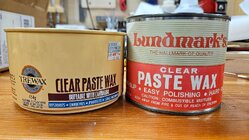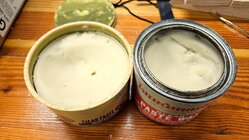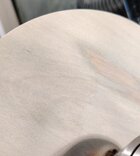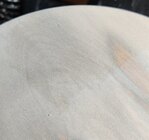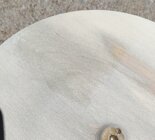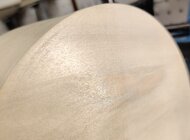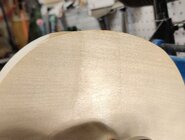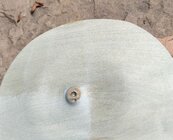This conversation started in another thread that is all about showcasing your latest on-lathe workpieces, and I don't want to derail the topic of that thread. So I'm starting this thread, to discuss finishing options for very light colored woods. I'm working on this piece right now, one of five or six pieces of this really nice, bright white (with very faint gray and rust colored staining) American Holly wood below. I have some other very light colored woods, mostly maple, but I have some white oak as well (not quite as light colored as the maple or holly, but light enough that I think it fits the discussion.) I actually also have four or five more pieces of the same kind of brigh white holly as below, that I will be turning over the next few days here.
So the question is, what is the best way to finish a piece like this holly, nicely, I generally prefer a satin sheen, and I really like to bring out the wood grain characteristics and chatoyance if there is any, while having a minimal to zero impact on the color of the wood. Color...vs, say, brightness? I know that most woods experience a darkening effect, which I wouldn't necessarily call a change in color in and of itself. I think the darkening is really more of a consequence of revealing the true color of the wood, more than anything, as light penetrates better with a finish, scatters less...I think its the scattering of light off of dry wood fibers, that leads to dry woods having a lighter and often "softer" appearance...
In any case, the goal is to limit changing the color of light woods when you finish them. I've had this problem most with maples, especially figured maples, which will often turn yellow or even a bright orange, when finished with any oil based or shellac finish (even very blond shellacs.) FWIW, I have mostly used oil based finishes, as well as shellac with polishing pastes and finishing waxes. Anything oil of course, is going to yellow the wood, but on most woods its not a problem. Its only really an issue, for these very light colored, white or very very light tan colored woods, where yellowing can have a significant impact on the color of the wood.
I have not used many water-based finishes. I tried some in the past, but I was never quite able to either get them to work the way I wanted, or they just produced a kind of finish I didn't really like? I think what I've tried, as far as water-based finishes goes, are polycrylic (hated this stuff!! Looks like a film over an air pocket over the wood!), Craft Coat (which is, in all honesty, something I don't entirely understand...IIRC it is some kind of modified oil, water-based, clear urethane finish of some kind...?), and a couple of water-based polys. Most of these finishes, ended up looking like a pure surface film over an air bubble on the surface of the wood. I don't think there was actually any air bubble, it just kind of looks that way. There seems to be basically zero penetration of the finish into the wood, so, most just didn't bring out the chatoyance or anything... That said, I suspect water-based finishes are the best option, for neutral color-impact finishes. I don't know if there may be other water-based finishes that, work better, or more similarly to oil based finishes? The "film sitting on top" without any penetration, is very unappealing to me personally, but if there is a water based finish that DOES have some penetration, and can coat the fibers a bit and, well, basically do what oil does, without the yellowing...then that would be quite interesting to me.
Craft Coat, was interesting, and I actually still have some, and it may be worth more experimentation. I think its clear, but, it is supposedly some kind of "modified oil" or something like that. I honestly don't quite understand what it is, and if anyone really does, I think it would be interesting to hear more details. I am afraid to use it on the piece below, unless I'm sure it will have zero color impact, or at least one so minor that it doesn't have a meaningful impact to the color. In the few cases I have used it, it did seem to bring out more of the characteristics of the wood...but at the same time, it also seemed to....shrink? I used it on some small spindles, and when first coated it looked like a CA finish, smooth and flat. Once it fully dried, though, it seemed to shrink wrap the pieces, and had a bit of a wrinkled appearance (I think it might have been nuances of the wood grain pushing through the finish?) That shrink-wrapped effect, is largely what turned me off of it, but I honestly don't know if it was poor application/user error, or an intrinsic characteristic of the finish.
I also have used shellacs. I just got home from the local Woodcraft. They carry a bunch of shellac flakes, from your dark amber up through super-blond (not sure how that compares to ultra blond). The sticker shock blew me through the shelving behind me: $62 for a 1/2lb bag!! I bought a bag of this stuff, probably the super blond, although I thought it was called ultra blond before, back in 2020, and IIRC it wasn't even half the cost it seems to be now. The cheapest bag was the medium toned flakes at $49 per 1/2lb, and the amber was about the same as the super blond. IIRC the brand was BT&C, and I guess they have a complex process involving steps in several different countries, before they actually import into the US. So there are probably multiple levels of tariffs involved now. I don't know of anyone has any recommendation for shellac flakes...I'd be interested in the most ultra blond flakes known to man, but in smaller quantities than half a pound...maybe an ounce or two. I think some ultra blond shellac, might do the trick for preserving the neutral colors of these very light woods.
I frequently use Zinsser's Bullseye SealCoat (sanding sealer), which seems to have a relatively neutral appearance, but I don't know if its neutral enough to have no color impact, or very minimal color impact, on something as light and white as holly. I'm afraid to even try it, but I may try to round and true up one of the other holly blanks, and see what this stuff looks like before I fully turn it, as a test case. I use the SealCoat on a lot of what I turn, as after sealing, I use Acks sanding paste and finishing wax to get a final slightly-shiny satin sheen. With light, figured maples, there is a slight change in color, but the maple isn't as white and bright as holly, so I don't think its a great test case for how this stuff might affect holly.
In the other thread, someone mentioned using just a stick of carnauba wax as a finish. I do have carnauba wax, however the sticks I have are very, very yellow. I've tried my hand at finishing small pieces, such as tops and even a couple of pens, with direct application of carnauba wax. The approach I take is to get it to melt, then spread it around and try to get an even coating. Applying carnauba without any streaking or anything like that, seems rather challenging, and this is all on very small pieces...don't know how well it would go on larger pieces. One of the holly blanks I have is a 14 or 15" platter blank, and another platter blank maybe an inch or so smaller than that. So there would be a lot of surface area to cover...honestly not sure how viable carnauba is for that. Would be curious to hear what others think of carnauba as a finish for larger pieces.
I don't know if there are any other viable options for color-neutral finishes. Oh, I guess, maybe, lacquer? I have some lacquer, although I haven't used them much. I have always had a bit of trouble applying lacquer, and I know there can be some complexity to lacquer finishes as you have different kinds (i.e. pre-cat, post-cat, etc.) and while most is sprayed, you can also brush it on. I also don't know if lacquer yellows over time, or maybe its just some types of lacquer that can yellow over time while others do not? I have some Watco, as well as a can of ProLux which is apparently the new name for what used to be the beloved Deft! I am quite sure the issues I have with lacquer are user error, and I may simply just not be applying enough in each coat (based on a tip someone recently gave me), but I don't know for sure. And I am also not sure if it is a good option for color-neutral finish. Would like to learn more, though!
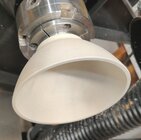
So the question is, what is the best way to finish a piece like this holly, nicely, I generally prefer a satin sheen, and I really like to bring out the wood grain characteristics and chatoyance if there is any, while having a minimal to zero impact on the color of the wood. Color...vs, say, brightness? I know that most woods experience a darkening effect, which I wouldn't necessarily call a change in color in and of itself. I think the darkening is really more of a consequence of revealing the true color of the wood, more than anything, as light penetrates better with a finish, scatters less...I think its the scattering of light off of dry wood fibers, that leads to dry woods having a lighter and often "softer" appearance...
In any case, the goal is to limit changing the color of light woods when you finish them. I've had this problem most with maples, especially figured maples, which will often turn yellow or even a bright orange, when finished with any oil based or shellac finish (even very blond shellacs.) FWIW, I have mostly used oil based finishes, as well as shellac with polishing pastes and finishing waxes. Anything oil of course, is going to yellow the wood, but on most woods its not a problem. Its only really an issue, for these very light colored, white or very very light tan colored woods, where yellowing can have a significant impact on the color of the wood.
I have not used many water-based finishes. I tried some in the past, but I was never quite able to either get them to work the way I wanted, or they just produced a kind of finish I didn't really like? I think what I've tried, as far as water-based finishes goes, are polycrylic (hated this stuff!! Looks like a film over an air pocket over the wood!), Craft Coat (which is, in all honesty, something I don't entirely understand...IIRC it is some kind of modified oil, water-based, clear urethane finish of some kind...?), and a couple of water-based polys. Most of these finishes, ended up looking like a pure surface film over an air bubble on the surface of the wood. I don't think there was actually any air bubble, it just kind of looks that way. There seems to be basically zero penetration of the finish into the wood, so, most just didn't bring out the chatoyance or anything... That said, I suspect water-based finishes are the best option, for neutral color-impact finishes. I don't know if there may be other water-based finishes that, work better, or more similarly to oil based finishes? The "film sitting on top" without any penetration, is very unappealing to me personally, but if there is a water based finish that DOES have some penetration, and can coat the fibers a bit and, well, basically do what oil does, without the yellowing...then that would be quite interesting to me.
Craft Coat, was interesting, and I actually still have some, and it may be worth more experimentation. I think its clear, but, it is supposedly some kind of "modified oil" or something like that. I honestly don't quite understand what it is, and if anyone really does, I think it would be interesting to hear more details. I am afraid to use it on the piece below, unless I'm sure it will have zero color impact, or at least one so minor that it doesn't have a meaningful impact to the color. In the few cases I have used it, it did seem to bring out more of the characteristics of the wood...but at the same time, it also seemed to....shrink? I used it on some small spindles, and when first coated it looked like a CA finish, smooth and flat. Once it fully dried, though, it seemed to shrink wrap the pieces, and had a bit of a wrinkled appearance (I think it might have been nuances of the wood grain pushing through the finish?) That shrink-wrapped effect, is largely what turned me off of it, but I honestly don't know if it was poor application/user error, or an intrinsic characteristic of the finish.
I also have used shellacs. I just got home from the local Woodcraft. They carry a bunch of shellac flakes, from your dark amber up through super-blond (not sure how that compares to ultra blond). The sticker shock blew me through the shelving behind me: $62 for a 1/2lb bag!! I bought a bag of this stuff, probably the super blond, although I thought it was called ultra blond before, back in 2020, and IIRC it wasn't even half the cost it seems to be now. The cheapest bag was the medium toned flakes at $49 per 1/2lb, and the amber was about the same as the super blond. IIRC the brand was BT&C, and I guess they have a complex process involving steps in several different countries, before they actually import into the US. So there are probably multiple levels of tariffs involved now. I don't know of anyone has any recommendation for shellac flakes...I'd be interested in the most ultra blond flakes known to man, but in smaller quantities than half a pound...maybe an ounce or two. I think some ultra blond shellac, might do the trick for preserving the neutral colors of these very light woods.
I frequently use Zinsser's Bullseye SealCoat (sanding sealer), which seems to have a relatively neutral appearance, but I don't know if its neutral enough to have no color impact, or very minimal color impact, on something as light and white as holly. I'm afraid to even try it, but I may try to round and true up one of the other holly blanks, and see what this stuff looks like before I fully turn it, as a test case. I use the SealCoat on a lot of what I turn, as after sealing, I use Acks sanding paste and finishing wax to get a final slightly-shiny satin sheen. With light, figured maples, there is a slight change in color, but the maple isn't as white and bright as holly, so I don't think its a great test case for how this stuff might affect holly.
In the other thread, someone mentioned using just a stick of carnauba wax as a finish. I do have carnauba wax, however the sticks I have are very, very yellow. I've tried my hand at finishing small pieces, such as tops and even a couple of pens, with direct application of carnauba wax. The approach I take is to get it to melt, then spread it around and try to get an even coating. Applying carnauba without any streaking or anything like that, seems rather challenging, and this is all on very small pieces...don't know how well it would go on larger pieces. One of the holly blanks I have is a 14 or 15" platter blank, and another platter blank maybe an inch or so smaller than that. So there would be a lot of surface area to cover...honestly not sure how viable carnauba is for that. Would be curious to hear what others think of carnauba as a finish for larger pieces.
I don't know if there are any other viable options for color-neutral finishes. Oh, I guess, maybe, lacquer? I have some lacquer, although I haven't used them much. I have always had a bit of trouble applying lacquer, and I know there can be some complexity to lacquer finishes as you have different kinds (i.e. pre-cat, post-cat, etc.) and while most is sprayed, you can also brush it on. I also don't know if lacquer yellows over time, or maybe its just some types of lacquer that can yellow over time while others do not? I have some Watco, as well as a can of ProLux which is apparently the new name for what used to be the beloved Deft! I am quite sure the issues I have with lacquer are user error, and I may simply just not be applying enough in each coat (based on a tip someone recently gave me), but I don't know for sure. And I am also not sure if it is a good option for color-neutral finish. Would like to learn more, though!


